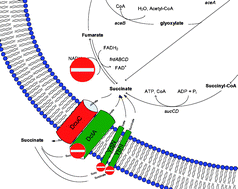Current climate issues and the ongoing depletion of oil reserves have led to increased attention for biobased production processes. Not only has the production of bio-energy gained interest, but also the production of biochemicals. Succinate is one of those biochemicals. In the presented work, the dicarboxylic acid transport system of Escherichia coli was modified to enhance production of succinate, a highly attractive chemical building block. The engineering comprised the elimination of succinate uptake and the overexpression of succinate export. However, succinate export in Escherichia coli is normally only active under anaerobic conditions and import only under aerobic conditions. Therefore, the gene responsible for succinate import, dctA, was knocked out and the gene coding for succinate export, dcuC, was overexpressed with a constitutive artificial promoter. In the applied batch cultivations, these modifications increased succinate yield and specific production rate more than 50% in a ΔsdhAΔsdhB background (0.16 C-mole/C-mole glucose and 0.17 C-mole/C-mole biomass/h, respectively), but also revealed alternative succinate import proteins, YdjN and YbhI. Mutations in the genes coding for these proteins led to increased growth rates and specific production rates, however, they did not increase succinate yield (e.g. the deletion of ybhI resulted in a growth rate of 0.54 h−1 and a specific production rate of 0.23 C-mole/C-mole biomass/h).

You have access to this article
 Please wait while we load your content...
Something went wrong. Try again?
Please wait while we load your content...
Something went wrong. Try again?


 Please wait while we load your content...
Please wait while we load your content...